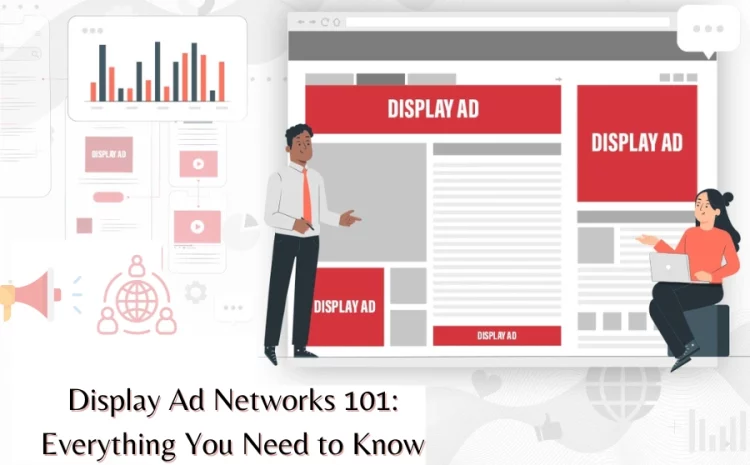Display Ad Networks 101: Everything You Need to Know
You’re strolling through your favorite website, engrossed in the latest articles or mesmerized by captivating visuals, and suddenly, an ad appears—not intrusive, but rather a harmonious addition to your online experience. How did it know exactly what you were looking for? The answer lies in the entangled realm of Display Ad Networks, where every pixel tells a story, and every click unveils a strategic dance between advertisers and publishers.
It stands as a stalwart, orchestrating the visual symphony that captures our attention across websites and platforms in the vast expanse of the digital marketing universe. Today, in this blog, we’re diving deep into ad networks. We’ll start with what they are, explore the tools your competitors might be using, and address the everyday challenges marketers face. Let’s get started.
Listen To The Podcast Now!
What Are Display Ad Networks?
At its core, a Display Ad Network is a sophisticated ecosystem that serves as the connective tissue between advertisers and publishers in the digital space. Such networks act as conduits for the seamless dissemination of visual advertisements across a myriad of online platforms.
The significance of Ad Networks transcends the mere display of images and messages. It is the architect of brand visibility, the catalyst for customer engagement, and the driving force behind business growth in the digital realm.
As we delve deeper, we will unravel the intricate mechanisms that make display and banner advertising networks indispensable tools in the arsenal of digital marketers. From targeted advertising to measurable analytics, the impact of these networks reverberates through the entire digital marketing ecosystem.
Crucial Components of Display Ad Networks
 Before delving into the intricate workings of display advertising networks, it’s essential to understand the expansive ecosystem of display advertising. This section provides a bird’s eye view of the dynamic interactions behind display advertising from the advertiser’s perspective.
Before delving into the intricate workings of display advertising networks, it’s essential to understand the expansive ecosystem of display advertising. This section provides a bird’s eye view of the dynamic interactions behind display advertising from the advertiser’s perspective.
To truly understand the mechanics of these networks, it’s essential to dissect the key components that drive their functionality and effectiveness.
A. Advertisers: Who They Are and What They Want
At the forefront of any successful display ad campaign are the visionaries—advertisers. These are the driving forces behind the compelling visuals and persuasive messages that seek to captivate audiences. For an efficient understanding of display ad networks, it is essential to understand advertiser motivations, strategies, and objectives.
Whether it’s enhancing brand visibility, driving sales, or promoting a message, advertisers bring life to the pixels that dance across our screens.
B. Publishers: Platforms for Display Ads
Publishers provide the canvas upon which the visual symphony unfolds.
These entities range from traditional websites to social media platforms, each offering a unique space for advertisers to showcase their messages. Such platforms open the door for display ads best practices.
Thus, publishers’ ad networks curate the digital spaces where audiences spend their time, and their role is pivotal in shaping the context in which ads display. The diversity of publishers contributes to the richness of the display ad networks landscape, offering advertisers various avenues to connect with their target demographics.
C. Ad Exchanges: Facilitating Ad Transactions
Beneath the surface of the visual spectacle lies the intricate machinery of ad exchanges. Ad exchange platforms serve as the virtual marketplace where the buying and selling of ad space occur in real time.
Ad exchanges facilitate seamless transactions between advertisers and publishers, ensuring that accurate ads find the most fitting digital homes.
The speed and efficiency of these exchanges are fundamental in the fast-paced world of display networks, where milliseconds can make the difference between a successful impression and a missed opportunity.
D. Ad Networks vs. Ad Exchanges: Understanding the Difference
The terms “ad networks” and “ad exchanges” are often used interchangeably, yet they represent distinct components within the display advertising ecosystem.
- Ad Networks: Ad Networks are entities that aggregate ad space from multiple publishers and offer it to advertisers as a package. Display Ad networks simplify the process for advertisers, providing a one-stop-shop for reaching diverse audiences across various digital spaces.
- Ad Exchanges: In contrast, ad exchanges operate as open-market platforms where advertisers and publishers engage in real-time bidding for ad space. Ad exchanges add a layer of dynamism and precision to the display advertising process, allowing for more granular control over where ads appear and at what cost.
Understanding this difference is crucial for advertisers seeking the most effective strategy for their campaigns, whether through the streamlined approach of ad networks, or by using google ads spy tool to gain a competitive edge , or the precision and flexibility of ad exchanges.
Types of Display Ad Networks
Following are the types of ad network:
A. Contextual Display Ad Network
Context is king, especially in the realm of display advertising. Contextual display ad network align advertisements with relevant content, ensuring that the message resonates with the audience. Here, we’ll explore how these networks navigate the digital landscape, connecting brands with the appropriate context.
B. Behavioral Ad Network
Understanding user behavior is a powerful tool in the hands of digital marketers. Behavioral ad networks leverage data insights to tailor advertisements based on user preferences, creating a personalized and engaging user experience.
C. Retargeting Display Ad Network
You do not need to forget lost leads. Retargeting ad network specialize in rekindling connections with users who have previously interacted with a brand, turning missed opportunities into conversion possibilities.
D. Social Media Display Ad Networks
Social media platforms are not just communication channels in the age of social connectivity; they are vibrant ecosystems for display advertising as well as a platform for ad spy tools and technologies.
Marketers and brands are leveraging tools like PowerAdSpy to track and spy competitor’s display ads.
PowerAdSpy
PowerAdSpy is a comprehensive advertising intelligence tool designed to help businesses and marketers gain insights into the advertising strategies of their competitors across various social media platforms, including Facebook, Instagram, and YouTube. Let’s delve deeper into the core features of PowerAdSpy:
Ad Campaign Monitoring
PowerAdSpy provides real-time tracking of live ad campaigns across major platforms. It helps marketers stay updated on current advertising trends and strategies employed by competitors and industry leaders.
Ad Database
Extensive repository of diverse ads for research and analysis. PowerAdSpy provides a vast database of 500 million plus ads.The software access a wealth of ad creatives for inspiration, market insights, and competitor analysis.
Advanced Search and Filters
PowerAdSpy has precise search capabilities using keywords, advertisers, and filters. It helps marketerts and brands find specific ad campaigns relevant to your interests, industry, or competitors.
Ad Analytics
PowerAdSpy provides in-depth insights into ad campaign performance metrics. Marketers gain insight into the effectiveness of ads in connecting with the audience and pinpointing successful strategies.
Targeting Information
The tool provides details on the target audience, demographics, and interests.
PowerAdSpy inform audience segmentation and refine targeting strategies based on successful campaigns.
Ad Placement Tracking
PowerAdSpy provides information on where ads are displayed, including specific placements. Optimize ad placement strategies for maximum visibility and effectiveness.
Ad Engagement Metrics:
The software helps marketers gain metrics such as likes, shares, comments, and click-through rates. Gauge the effectiveness of ad campaigns and identify areas for improvement.
Competitor Analysis:
PowerAdSpy provides cutting edge to competitor advertising tracking strategies and tactics. Stay competitive by adapting to market trends and avoiding pitfalls observed in competitors’ campaigns.
These features collectively empower users with comprehensive insights, aiding in informed decision-making, strategic planning, and staying ahead in the dynamic landscape of digital advertising.
Read More:
The Power of Competitor Display Ads: A Quick Overview
Why Should You Care About Ad Networks?
Challenges and Concerns in Display Advertising
A. Ad Fraud and Click Fraud
The darker side of the digital landscape involves threats like ad fraud and click fraud. Ad fraud and click fraud are continuously addressed with the help of advanced technology, machine learning algorithms, and collaboration between advertisers, publishers, and ad platforms.
Advertisers should stay vigilant and implement preventive measures to mitigate the impact of fraudulent activities on their advertising campaigns.
B. Ad Blockers and Their Impact
Ad blockers enhance user experience by eliminating unwanted online ads and improving privacy and security. However, they result in revenue loss for publishers and reduced ad effectiveness for advertisers. Industry responses encompass adapting ad formats, implementing anti-ad blocker technologies, and educating users to achieve a balance between user choice and sustaining the free internet ecosystem.
C. Privacy Concerns and Regulations
Privacy concerns center on extensive data collection, user profiling, and surveillance practices exacerbated by high-profile data breaches. Regulations, including GDPR, CCPA, and others globally, mandate transparent data processing, user consent, and protection of personal information. Stricter oversight and scrutiny of tech companies aim to balance innovation with safeguarding individual privacy.
Final Words
Display ad networks play a pivotal role in the digital advertising landscape, facilitating a symbiotic relationship between advertisers and publishers. These networks streamline the process of connecting advertisers seeking to promote their products or services with publishers offering ad space on their digital properties.
The dynamic nature of display ad networks enables advertisers to reach a vast and targeted audience, fostering brand visibility and engagement.
Advertisers benefit from the extensive reach and targeted capabilities of display ad networks, allowing them to tailor campaigns based on demographics, interests, and online behavior. On the flip side, publishers leverage these networks to monetize their digital assets efficiently, generating revenue through ad placements. However, challenges such as ad fraud and the rise of ad blockers necessitate ongoing innovation and adaptability within the industry.
As technology evolves, display ad networks are likely to incorporate advanced targeting methodologies, enhanced analytics, and more engaging ad formats to meet the evolving expectations of both advertisers and users.
Striking a balance between user experience, privacy concerns, and effective advertising will remain a key focus. In essence, display ad networks represent a dynamic and indispensable component of the digital advertising ecosystem, continuously shaping and reshaping the landscape of online advertising.








